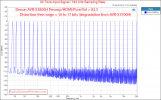Things to think about:
- An RZ70 (or 8.4 or LX805) would probably make your Emotiva redundant - plenty of power/current
- The X4800/X3800 and RZ50/NR7100 are all current constrained - there are differences between them, but none of these will provide the power and current that your Emotiva currently does.
- As pre-amps all of these are within the same performance zone... (when properly set up and level matched you probably would be unable to differentiate between them blind)
- Any of these should be able to replace the LX701 in your setup without any fuss (while keeping the Emotiva, or for the RZ70, possibly retiring the Emotiva)
- If you want to go down the DLBC route - then the RZ70 provides an immediate option (it is available now) - and the Denon's will have that option in about a years time (I think Masimo was talking about March 2024?)
- If what you want is Dirac - and you aren't fussed about DLBC (or you are OK with potentially trading in an AVR for a DLBC upgrade next year...) - then the RZ50 is fantastic value - an alternative option given the number of channels you are running - would be the Integra DRX 3.4 - prices vary regionally.... in some places the RZ50 is cheaper (!) - but where I am (Australia) there was a substantial saving in stepping down to the 3.4 - which is the same as the NR7100, but with full pre-outs - the 3.4 will give you all the same features as the RZ50, minus one channel... and with a bit less power, which won't be an issue as you have the Emotiva in place. (I run a 3.4, with a Crown XLS amp driving L/R, and the 3.4 running the rest of my 5.1.4 setup)
- Audyssey - it's a bit more fiddly/messy to get right, but with the smartphone app and some messing about, reports are very positive - and the X3800 with Audysey is a competitive solution - if you are tempted to spend the extra $200 for the Multeq-X app, then possibly a Dirac based solution would be better value.
The Denon's were on my short list - but I ended up opting for Dirac and Onkyo/Integra as my better value immediate option, in the knowledge the within 3 years I will probably be trading my Integra for something capable of Dirac ART.... I'm planning on skipping the DLBC generation...
I moved from an older version of Audyssey XT32 to Dirac Live - and the result was an immediate noticeable improvement in performance... (and yes, that generation did not have the option of the apps to tune it, and MRC was not able to be turned off, and the improvement was most likely due to MRC...)
It's a difficult decision... with a lot of variables... but these are the AVR's that were/are on my short list too.
